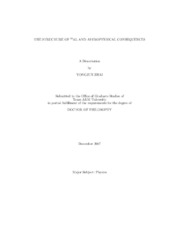| dc.description.abstract | Motivated by existing nuclear astrophysics problems, the B-decay of the proton
rich nucleus 23Al was studied for the first time with pure samples which were
obtained by using the 1H(24Mg,23Al)2n reaction and the MARS recoil separator at
Texas A&M University. B and B-y
coincidence measurements were made with a fast
tape-transport system, scintillator, BGO and HPGe y
detectors. The experiment
allowed us to measure absolute B branching ratios and to determine logft values for
transitions to final states in 23Mg, including the isobaric analog state (IAS), and,
therefore, to determine unambiguously the spin and parity of the 23Al ground state
to be J^Pi = 5/2+. This work excludes the large increases in the radiative proton capture
cross section for the reaction 22Mg(p,
)23Al at astrophysical energies, which were
implied by claims that the spin and parity of the 23Al ground state were J^Pi = 1/2+.
More precise half life and mass determinations of 23Al were obtained from the experimental
data. The logft for the Fermi transition to its isobaric analog state in
23Mg was also determined for the first time. This IAS and a state 16 keV below it
were observed, well separated in the same experiment for the first time. The B-decay
scheme of the proton rich nucleus 23Al was established. We can now solve a number
of inconsistencies in the literature, exclude strong isospin mixing claimed before, and obtain a new determination of the resonance strength. The IAS and the state 16 keV
below it are resonances in the 22Na(p,
)23 Mg reaction at energies that are important
in novae. This second state turns out to be the resonance that gives the most
important contribution in the depletion of 22Na from novae. Both of the reactions
of 22Mg(p,
)23Al and 22Na(p,
)23Mg have been suggested as possible candidates for
diverting some of the flux in oxygen-neon novae explosions from the A=22 into the
A=23 mass chain. | en |


